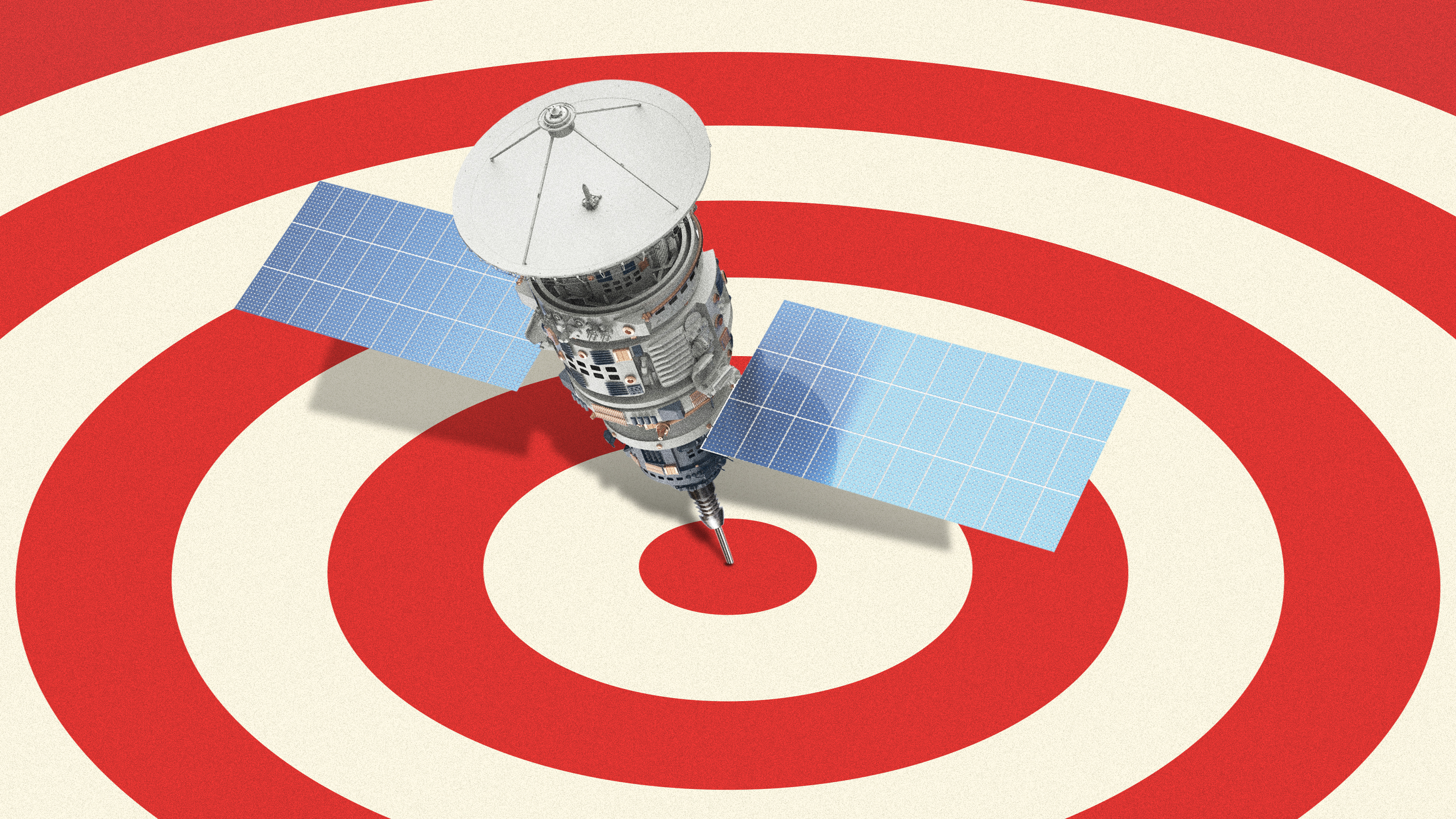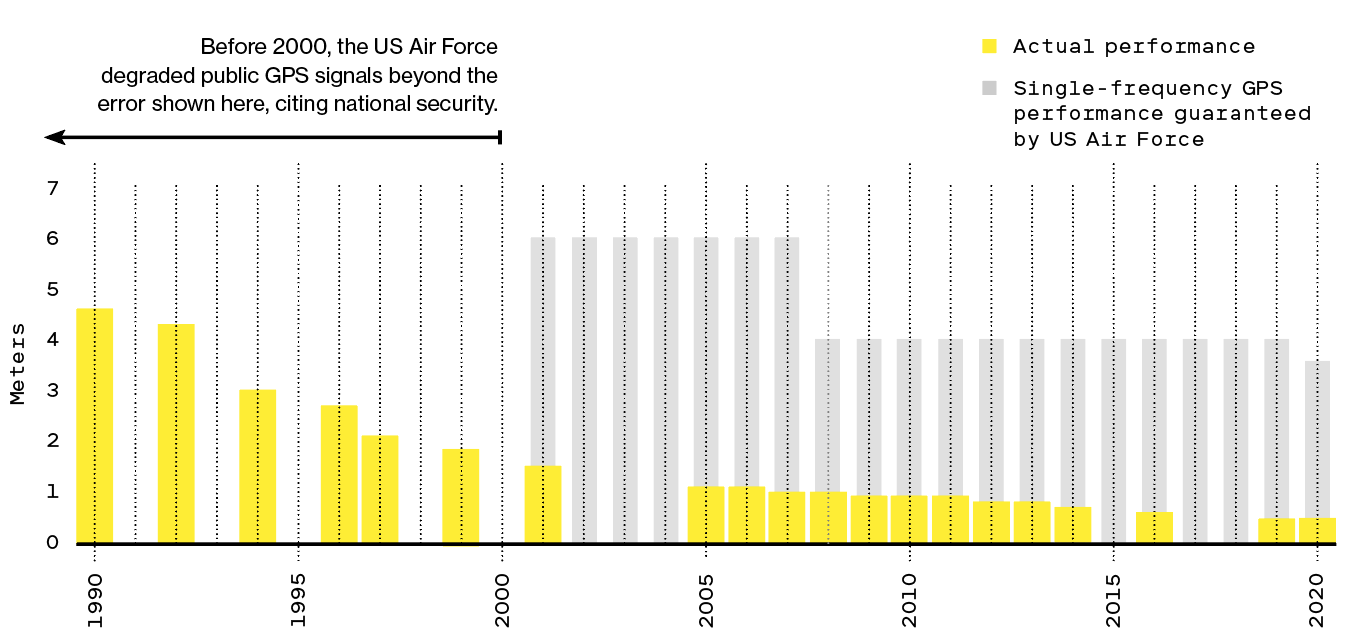Hyper-accurate positioning is rolling out worldwide
Upgrades to satellites in orbit and systems down below will bring centimeter-level accuracy to the masses.

Why it matters:GPS has already transformed many industries and enabled whole new ones, like ride-sharing. A more accurate form of it will spawn yet more applications.
Key players:• China National Space Administration
• US Air Force
• ColdQuanta
Availability:Now
A massive landslide—the worst in decades—struck Du Fangming’s home in south China’s Hunan province on July 6. “My house collapsed. My goats were swept away by the mud,” he told Chinese media outlets shortly after the catastrophe. Fortunately, though, he was safe—one of 33 villagers who had been evacuated thanks to early warnings enabled by advanced positioning technologies that can provide more accurate readings than ever before.
Powered by China’s newly completed global navigation satellite system, BeiDou (“the Big Dipper”), and its ground-based stations, position sensors can detect subtle changes in the land’s surface in landslide-prone regions across China. Movement over a few meters can be spotted in real time, while post-processing accuracy can reach the millimeter level.
That means a shift in the dirt about the size of the tip of a sharp pencil can be spotted from more than 21,000 kilometers above. Twelve days before the landslide, Du’s village received an orange alert citing data anomalies, which pointed to accelerating surface sliding following days of heavy rain.
Twelve days before the landslide, Du’s village received an orange alert citing data anomalies, which pointed to accelerating surface sliding following days of heavy rain.
Du’s village is among the more than 100 sites in Hunan that are equipped with such disaster-monitoring and early-warning systems. “This service wouldn’t have been possible if satellite-based positioning accuracy had still been at the meter or decimeter level,” says Yuan Hong of the Aerospace Information Research Institute at the Chinese Academy of Sciences in Beijing, where he worked for decades on BeiDou.
More than ever, we rely on technologies that can determine our location or pinpoint an object’s position. Precision agriculture, drone delivery, logistics, ride-hailing, and air travel all depend on highly accurate position detection from space. Now a series of deployments and upgrades are boosting the accuracy of the world’s most powerful global satellite positioning systems from several meters to a few centimeters.
That could mean your phone knows not only which street you’re walking or biking down, but what side of the street you’re on. Someday, that kind of resolution could make it possible for self-driving cars or delivery robots to safely navigate streets and sidewalks.
GPS keeps getting better
As technology improves, so does the accuracy of GPS, represented here by a statistical average of the signal-in-space error measured on a single frequency across the GPS constellation.

New and improved satellites
The Global Positioning System (GPS), one of the world’s first such satellite systems, has changed the way billions of people move around. Since 1993, at least 24 GPS satellites have been orbiting the Earth and constantly broadcasting their positions. Any GPS receiver can find its current whereabouts within seconds by triangulating signals from at least three satellites in the constellation.
Once the signals are processed by a receiver, GPS is generally accurate to within five to 10 meters. Now the system is in the middle of a years-long upgrade to GPS III, which should improve its accuracy to one to three meters (see chart). By November 2020, four of the 10 GPS III satellites had launched, with the rest expected to be put into orbit by 2023. Though consumers won’t notice it right away, the accuracy of their navigation systems and smartphone tracking apps should improve as a result.
And in June 2020, China finished deploying its BeiDou satellite constellation as a GPS alternative. Expanded over two decades’ time from a regional to a global network, BeiDou now has 44 satellites operating in three distinct orbits. It provides positioning services to anyone in the world with an average accuracy of 1.5 to two meters. Since the service has a historical focus on China and Asia, however, BeiDou’s regional users can often get better location information, close to one meter in precision.
Boosting accuracy on the ground
Even with these advances, positioning signals encounter interference and other conditions that can make them go awry. Correcting these errors requires another layer of technology.
Both BeiDou and GPS rely heavily on ground-based augmentation to boost positioning accuracy to the centimeter level. One popular approach is real-time kinematic (RTK) positioning, which uses a base receiver and a rover receiver, placed kilometers apart, to receive satellite signals and calculate the errors caused by Earth’s ionosphere. This technique can achieve accuracies of less than three centimeters.
A similar but newer technology is precise point positioning (PPP). It requires only one receiver and works from anywhere on Earth’s surface, giving users decimeter- to centimeter-level accuracy.
In China, RTK augmentation is relatively mature, and thousands of base stations have been built across the country, Yuan says: “We are now developing a technology called PPP-RTK to combine their strengths, and [will] hopefully put it to use a few years from now.”
Beyond satellite positioning
As the accuracy of satellite positioning improves, we’ll no doubt find even more ways to use it. Eventually, though, traditional satellite systems will reach an accuracy limit—probably around the millimeter level. So researchers are exploring new positioning technologies that could take us beyond that limit or at least reduce our reliance on satellites.
One approach uses the quantum properties of matter to locate and navigate without outside references. When atoms are cooled down to just above absolute zero, they reach a quantum state that is particularly sensitive to outside forces. Thus, if we know an object’s initial position and can measure the changes in the atoms (with the help of a laser beam), we can calculate the object’s movements and find its real-time location.
Quantum positioning would be particularly useful in situations where satellite systems such as GPS or BeiDou are not available, such as in deep space or underwater, or as a backup navigation technology for self-driving cars. A very early version of a quantum positioning system, developed by ColdQuanta in Boulder, Colorado, is now operating on the International Space Station.
Our ancestors looked to stars and compasses to figure out where they were; today, we use atomic clocks on satellites in orbit to do the same. New positioning technologies have already changed the way we farm, transport goods, and navigate our world, and the latest improvements will bring that world into even sharper focus. As positioning technology advances to the millimeter level and beyond, the limits of its use will be defined more by our creativity and the legal or ethical bounds we set than by the performance of the technology itself.
Deep Dive
Space
How to safely watch and photograph the total solar eclipse
The solar eclipse this Monday, April 8, will be visible to millions. Here’s how to make the most of your experience.
The great commercial takeover of low Earth orbit
Axiom Space and other companies are betting they can build private structures to replace the International Space Station.
How scientists are using quantum squeezing to push the limits of their sensors
Fuzziness may rule the quantum realm, but it can be manipulated to our advantage.
Stay connected
Get the latest updates from
MIT Technology Review
Discover special offers, top stories, upcoming events, and more.